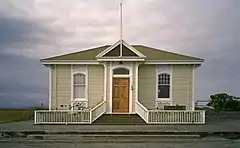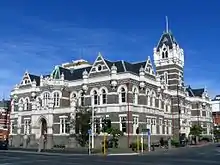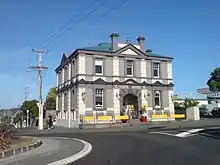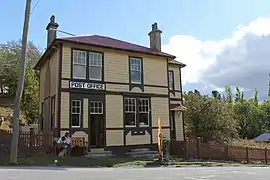John Campbell (architect)
John Campbell (4 July 1857 – 4 August 1942) was a New Zealand architect, responsible for many government buildings in New Zealand, among them the Dunedin Law Courts, the Public Trust Building in Wellington, and Parliament House. From 1909 until his retirement in 1922 he held the position of government architect.[1]
John Campbell | |
|---|---|
_(cropped).jpg.webp) Campbell c. 1892 | |
| Born | 4 July 1857 Glasgow, Scotland |
| Died | 4 August 1942 (aged 85) Wellington, New Zealand |
| Occupation | Architect |
| Spouse(s) | Mary Jane Marchbanks
(m. 1889) |
| Buildings | Dunedin Law Courts Wellington Public Trust Building , Parliament House |
Early life and education
Campbell was born on 4 July 1857 in Glasgow, Scotland to Janet (nee McKechnie) and Donald Campbell, a ship’s chandler.[2] He was educated first at the Haldane Academy and then the Glasgow School of Art. [3]
Career
After leaving school Campbell undertook an apprenticeship between 1872 and 1876 with architect John Gordon.[2] Upon completion of his apprenticeship he remained with the firm as an assistant draughtsman until leaving Gordon’s practice in 1880.[3] He subsequently emigrated to New Zealand in 1882.[4]
Enters New Zealand government service
After arriving in New Zealand, he worked for the firm of Mason and Wales for a short time before in 1883 taking up a temporary position as an architectural draughtsman in the Dunedin office of the Public Works Department.[2][3] While there he was responsible His first known work was an unbuilt design from the mid-1880s for the Dunedin railway station. The earliest buildings constructed to his design, were predominantly Queen Anne in style and included the Porirua Lunatic Asylum (1894) and the Dunedin Prison (1895–98) which was reminiscent of Norman Shaw's New Scotland Yard in London. Since the sudden death of William Cayton in 1877 his position of Colonial Architect had not been filled. Instead his Chief Draughtsman Pierre Finch Martineau Burrows had undertaken responsibility for the design of government buildings until he was let go in a cost saving measure in 1884, which downsized the government’s architectural section.[3] Despite this Campbell stayed on in government service.
Transfers to Wellington
In 1888, Campbell was transferred to Wellington and in 1889, he was appointed to the position of draughtsman-in-charge in the newly created Public Buildings Department.[5] Campbell’s appointment effectively gave him responsibility for a staff of up to 10 who between them undertook the design of all government buildings in New Zealand. Notable among them were William Crighton (1861–1928), Llewelyn Richards (1865–1945) and Claude Paton (1881–1953).[3] The Public Buildings Department subsequently merged with the Public Works Department (PWD) in 1890 with Campbell retaining his responsibility.[5] His pragmatic professionalism contributed to establishing architects as an important part of the PWD.[3] For much of his career, Campbell worked for the Liberal Government (1891–1912), designing the buildings needed to support an administration which was committed to wide-ranging social and economic reforms. His design for the Dunedin Law Courts building which was completed in 1902 was an adaptation of an earlier design for a railway station whose plan is a precursor of Campbell's later design for the Parliament House in Wellington.
As his career progressed his designs were increasingly Edwardian Baroque, a style he successfully established as the official architectural style for government buildings (such as police stations, courthouses and post offices) in New Zealand in the early twentieth century. Among them were buildings as diverse in function as the Magistrate's Court, Wellington (1901–3), the Napier Government Buildings (1902–7) and the Public Trust Office, Wellington (1905–9). His office was responsible for design and construction of a large number of post offices between about 1900 and 1914. Among them were the similar Auckland and Wellington chief post offices. For the smaller post offices two designs were widely reproduced across the country. The Government Buildings in Hokitika, designed by Campbell in two stages, in 1907 and 1911, are a more restrained expression of his characteristic Imperial Baroque style.[6] The crowning achievement of Campbell’s career was winning the commission in 1911 (following a nation-wide architectural competition) to design Parliament House in Wellington. At the time of its construction it was the most ambitious architectural project attempted in New Zealand.[5]
Appointed architect
Campbell's position was changed to that of “Architect” in 1899.[5] In 1905 Campbell was elected a fellow of both the New Zealand Institute of Architects and the Royal institute of British Architects.[3] He was given the title of “Government Architect” in 1909 and held it until his retirement.[5] He was the first to hold this title. He was succeeded as Government Architect by John Mair. Campbell assisted in the founding of the first Architectural Students Association in Wellington.[4]
Retirement
Upon his retirement in 1922 he was succeeded by John Mair as Government Architect.[5] Following his retirement Campbell travelled extensively.[4] John Campbell died in Wellington on 4 August 1942 and is buried in Karori Cemetery.[2][7]
Personal life
Campbell was married by the Rev. Dr Stuart to Mary Jane Marchbanks, the second daughter of David Marchbanks on 18 April 1889 at Queen Street north in Dunedin.[8] It appears that the couple had no children.[4] For many years he was a member of the board of management of St. John's Presbyterian Church.[4]
His wife, Mary Jane Campbell, died in 1950.[9]
Works
Among the buildings which Campbell personally designed, collaborated on or supervised the design of are:
| Building | Image | Completed | Location | Notes |
|---|---|---|---|---|
| Campbell House | 1892 | 21 Salamanca Road, Kelburn, Wellington | The building was designed by Campbell as his family home.[10] | |
| Kaikōura Post Office | _05.JPG.webp) | 1893 | 1 Torquay Street, Kaikōura | Granted Heritage New Zealand historic place category 2 status in 2006.[11] |
| Porirua Lunatic Asylum [3] | 1894 | Porirua | Constructed 1891–94. This was subsequently demolished.[2] | |
| Ashhurst Post Office | 1897 | 64 Bamfield Street, Ashhurst | Granted Heritage New Zealand historic place category 2 status in 2010.[12] | |
| Featherston Courthouse[3] | 1897 | Featherston | ||
| Hokitika Customhouse [3] |  | 1897 | Gibson Quay, Hokitika | Granted Heritage New Zealand historic place category 1 status in 1990[13] |
| Marton Courthouse[3] | 1897 | 23 High Street, Marton | Granted Heritage New Zealand historic place category 1 status in 1985.[14] | |
| Dunedin Prison | .jpg.webp) | 1898 | 2 Castle Street, Dunedin | The design was completed in 1892 but construction didn’t start until 1895 and after a number of delays it was completed in 1898. It was later used as a police station. Granted Heritage New Zealand historic place category 1 status in 1984.[15] |
| Waitekauri Post Office[3] | 1898 | Waitekauri | ||
| Clyde Post Office[3] | 1900 | 4 Blyth Street, Clyde | Extended in 1909.[3] Granted Heritage New Zealand historic place category 2 status in 2005.[16] | |
| Tākaka Post Office[3] |  | 1900 | 73 Commercial Street, Tākaka | Granted Heritage New Zealand historic place category 2 status in 2004.[17] |
| Collingwood Courthouse[3] |  | 1901 | Corner of Elizabeth Street and Gibbs Road, Collingwood | Granted Heritage New Zealand historic place category 2 status in 2004.[18] |
| Hamilton Post Office | 1901 | 114–120 Victoria Street, Hamilton | Completed 1901. It was then extended in 1916.[3] Granted Heritage New Zealand historic place category 2 status in 1990.[19] | |
| Naseby Post Office[3] | 1901 | 14–16 Derwent Street, Naseby | Granted Heritage New Zealand historic place category 2 status in 2011.[20] | |
| Parliamentary Library[3] | 1901 | Parliament Grounds, Molesworth Street, Te Aro, Wellington | Constructed 1899–1901. The building was originally designed by Thomas Turnbull and was completed by Campbell after Turnbull resigned from the project following the government’s decision to reduce to height of the building to save money. Campbell redesigning the parapets, gables, and roof to accommodate the reduction in the building’s height.[21] | |
| Opunake Courthouse [3] | 1901 | 104 Tasman Street, Opunake | Opened in November 1901 with its official opening in February 1902. Granted Heritage New Zealand historic place category 2 status in 1983.[22] | |
| Waihi Courthouse[3] |  | 1901 | 61 Kenny Street, Waihi | Granted Heritage New Zealand historic place category 1 status in 1990.[23] |
| Dunedin Law Courts[3] |  | 1902 | 1 Stuart Street, Dunedin | Granted Heritage New Zealand historic place category 1 status in 1987.[24] |
| Onehunga Post Office[3] |  | 1902 | 120 Onehunga Mall, Onehunga | Granted Heritage New Zealand historic place category 2 status in 1993.[25] |
| Temuka Post Office [3] | 1902 | 59 King Street and Domain Avenue, Temuka | Constructed in 1901–1902. Granted Heritage New Zealand historic place category 2 status in 1983.[26] | |
| Wanganui Post Office [3] | 1902 | Wanganui | ||
| Hunterville Post Office[3] | 1903 | 10 Bruce Street, Hunterville | Granted Heritage New Zealand historic place category 1 status in 1990.[27] | |
| Newton Police Station[3] | 1903 | Auckland | ||
| Tauranga Post Office and Government Building [3] | 1905 | Tauranga | ||
| Dannevirke Courthouse[3] | 1905 | Gordon Street, Dannevirke | Granted Heritage New Zealand historic place category 2 status in 1986.[28] | |
| Animal Research Laboratory [3] | 1905 | 70 Ward Street, Wallaceville, Upper Hutt | Granted Heritage New Zealand historic place category 1 status in 1985.[29] | |
| Collingwood Courthouse [3] | 1906 | Collingwood | ||
| Government Building, Tauranga |  | 1906 | 141 Harington Street, Tauranga | Granted Heritage New Zealand historic place category 1 status in 1983.[30] |
| Dominion Observatory [31] | 1907 | Wellington | ||
| Government Building, Napier | 1907 | Napier | Constructed 1902–7. Destroyed by the 1931 earthquake.[2] | |
| Manakau Post Office | 1907 | 33 Honi Taipua Street, Manakau | Granted Heritage New Zealand historic place category 2 status in 1985.[32] | |
| Cambridge Post Office[3] | 1908 | 43 Victoria Street, Cambridge | Granted Heritage New Zealand historic place category 2 status in 1985.[33] | |
| Eltham Courthouse[3] | 1908 | Eltham | ||
| Te Kuiti Courthouse[3] | 1908 | Te Kuiti | ||
| Te Kuiti Public Works Department Office[3] | 1908 | Te Kuiti | ||
| Roslyn Post Office[3] | 1908 | Dunedin | ||
| Government Bathhouse[3] | 1908 | Government Gardens, Rotorua | Constructed 1905–1908, with a southern extension added in 1911–1912. Granted Heritage New Zealand historic place category 1 status in 1985.[34] | |
| Waitomo Caves Hotel[3] |  | 1908 | 27D Waitomo Village Road and Access Road, Waitomo | Granted Heritage New Zealand historic place category 2 status in 1990.[35] |
| Cambridge Courthouse[3] | 1909 | Cambridge | Granted Heritage New Zealand historic place category 2 status in 1985.[36] | |
| Government Building, Greymouth [3] | 1909 | Greymouth | ||
| Epsom Post Office | 1909 | 311 Manukau Road and Kimberley Road, Epsom, Auckland | The two-storey brick building originally had a Marseilles-tiled roof and rough-cast finish. In 1937 the exterior was modernised and a flat-roofed office was added. Granted Heritage New Zealand historic place category 2 status in 2010.[37] | |
| Matakohe Post Office [3] | 1909 | Matakohe | ||
| Public Trust Building |  | 1909 | Corner of 131–135 Lambton Quay and Stout Street, Te Aro, Wellington | Designed in conjunction with Llewelyn Richards.[3][38] Granted Heritage New Zealand historic place category 1 status in 1981.[39] |
| St Bathans Post Office[3] |  | 1909 | 1680 Loop Road, St Bathans | Granted Heritage New Zealand historic place category 2 status in 2007.[40] |
| Bannockburn Post Office[3] | 1910 | Bannockburn | ||
| Government House[3] | 100px | 1910 | 1 Rugby Street, Newtown, Te Aro, Wellington | Constructed 1908–1910. The building was principally designed by Campbell’s assistant, Claude Paton.[41] |
| Mornington Post Office[3] | 1910 | Dunedin | ||
| Ongaonga Post Office | .JPG.webp) | 1910 | 55 Bridge Street, Ongaonga | Granted Heritage New Zealand historic place category 2 status in 1983.[42] |
| Government Building, Stratford[3] | 1911 | Stratford | ||
| Kingsland Post Office[3] | 1911 | Kingsland, Auckland | ||
| Ōpōtiki Courthouse |  | 1911 | 119 Church Street, Ōpōtiki | Granted Heritage New Zealand historic place category 2 status in 1984.[43] |
| Shannon Post Office |  | 1911 | 2 Stout Street, Shannon | Granted Heritage New Zealand historic place category 2 status in 1982.[44] |
| General Headquarters Building[45] | 1912 | 213–215 Taranaki Street and Buckle Street, Mt Cook, Wellington | Originally known as the Defence Stores Office. Granted Heritage New Zealand historic place category 2 status in 2003.[46] | |
| Greymouth Courthouse[3] | 1912 | Greymouth | ||
| Masterton Courthouse[3] | 1912 | Masterton | ||
| Ponsonby Post Office | 1912 | 1–3 St Marys Bay Road, Auckland | Designed by Campbell in association with Claude Paton.[3] | |
| Waikouaiti Post Office[3] | 1912 | Dunedin | ||
| Chief Post Office | 1912 | 12 Queen Street, Auckland | Designed by Campbell and Claude Paton. Constructed 1909–1912.[47] | |
| Government Buildings, Hokitika |  | 1913 | 14 Sewell Street, Hokitika | The first half of the building, including the central entrance bay, was completed in 1909. The south end was extended between 1912–13 and it was occupied from 1914 onwards. Granted Heritage New Zealand historic place category 1 status in 1990.[48] |
| Magistrates District Court[3] | 1913 | Auckland | Designed by Campbell and Claude Paton.[3] | |
| Otorohanga Courthouse [3] | 1913 | Otorohanga | ||
| Brooklyn Post Office | 1914 | 22 Cleveland Street, Brooklyn, Wellington | The plans were drawn by drawn by Stuart R. Tennent.[49] | |
| Dargaville Post Office | 1914 | Dargaville | Designed by Campbell in association with Claude Paton.[3] | |
| North East Valley Post Office[3][50] | 1914 | 282 North Road and Calder Avenue, Dunedin | ||
| Remuera Post Office[3] | 1914 | Auckland | ||
| Rotorua Post Office. [3] | 1914 | Rotorua | ||
| St John’s Post Office[3] | 1914 | 373 Victoria Ave, Wanganui | Granted Heritage New Zealand historic place category 2 status in 1982.[51] | |
| Taranaki Street Police Station[3] | 1915 | 25–29 Taranaki Street, Te Aro, Wellington | ||
| Central Police Station | 1917 | 31–35 Waring Taylor Street and 36–40 Johnston Streets, Wellington | Constructed 1914–17.[52] | |
| Oamaru Police Station |  | 1919 | 14–16 Severn Street, Oamaru | Granted Heritage New Zealand historic place category 2 status in 1982.[53] |
| Wellesley St Telephone Exchange[3] | 1922 | Auckland | ||
| Native Land Court and Aotea Māori Land Board Building |  | 1922 | 11 Rutland Street, Whanganui | Granted Heritage New Zealand historic place category 1 status in 2008.[54] |
| Parliament House | .jpg.webp) | 1922 | 1 Molesworth Street, Wellington | * Constructed 1912–21. Designed by Campbell in association with Claude Paton.[55] Only one wing was completed. Granted Heritage New Zealand historic place category 1 status in 1989.[56] |
| Khandallah Automatic Telephone Exchange | 1922 | 86–88 Khandallah Road, Khandallah, Wellington | Constructed 1918–22.[57] | |
| Pearce Block, Southland Boys' High School | 1922 | Herbert St, Invercargill | Campbell completed the design of the building prior to his retirement and it was constructed under the supervision of his successor John Mair.[3] |
References
- "Campbell, John". New Zealand Historic Places Trust. Retrieved 28 December 2009.
- Richardson, Peter (1993). "Campbell, John". Te Ara – the Encyclopedia of New Zealand. Retrieved 30 September 2020.
- Martin, Lewis E. (2004). Built for Us: The Work of Government and Colonial Architects, 1860s to 1960s (hardback). Dunedin: University of Otago Press. pp. 33, 42–113. ISBN 1-877276-64-2.
- "Obituary: Mr. John Campbell", Evening Post, 5 June 1942, retrieved 12 August 2020CS1 maint: date and year (link)
- "The Government Architect's Office: 1857–1942". Te Kāhui Whaihanga New Zealand Institute of Architects. Retrieved 11 August 2020.
- "Government buildings (former)". Heritage New Zealand. Retrieved 13 September 2020.
- "Cemetery record (John Campbell)". Wellington City Council. Retrieved 5 October 2020.
- "Marriage", Otago Daily Times, 19 April 1889, retrieved 10 August 2020CS1 maint: date and year (link)
- "Cemetery record (Mary Jane Campbell)". Wellington City Council. Retrieved 5 October 2020.
- "Campbell House (Former)". Wellington Heritage. 24 November 2016. Retrieved 11 August 2020.
- "Post office complex (former)". Heritage New Zealand. Retrieved 5 October 2020.
- "Post office (former)". Heritage New Zealand. Retrieved 5 October 2020.
- "Customhouse (former)". Heritage New Zealand. Retrieved 5 October 2020.
- "Marton courthouse (former)". Heritage New Zealand. Retrieved 5 October 2020.
- "Dunedin Prison (Former)". Heritage New Zealand. 2020. Retrieved 7 October 2020.
- "Clyde Post Office (Former)". Heritage New Zealand. Retrieved 8 October 2020.
- "Takaka Post Office (former)". Heritage New Zealand. Retrieved 5 October 2020.
- "Collingwood Courthouse (former)". Heritage New Zealand. Retrieved 5 October 2020.
- "Hamilton Post Office (Former)". Heritage New Zealand. Retrieved 8 October 2020.
- "Naseby Post Office (former)". Heritage New Zealand. Retrieved 5 October 2020.
- "Government House". Wellington Heritage. 29 November 2016. Retrieved 11 August 2020.
- "Courthouse (Former)". Heritage New Zealand. Retrieved 8 October 2020.
- "Waihi Courthouse". Heritage New Zealand. Retrieved 6 October 2020.
- "Dunedin law courts". Heritage New Zealand. Retrieved 5 October 2020.
- "Onehunga post office (former)". Heritage New Zealand. Retrieved 6 October 2020.
- "Post Office (Former)". Heritage New Zealand. Retrieved 8 October 2020.
- "Hunterville post office (former)". Heritage New Zealand. Retrieved 5 October 2020.
- "Courthouse". Heritage New Zealand. Retrieved 8 October 2020.
- "Wallaceville Animal Research Centre Veterinary Laboratory (Former)". Heritage New Zealand. Retrieved 8 October 2020.
- "Post office/Government building (former)". Heritage New Zealand. Retrieved 6 October 2020.
- "Dominion Observatory". Wellington Heritage. 23 November 2016. Retrieved 11 August 2020.
- "Post office (former)". Heritage New Zealand. Retrieved 5 October 2020.
- "Cambridge Post Office (Former)". Heritage New Zealand. Retrieved 8 October 2020.
- "The Bath House (Former)". Heritage New Zealand. Retrieved 8 October 2020.
- "Waitomo Hotel". Heritage New Zealand. Retrieved 5 October 2020.
- "Courthouse (Former)". Heritage New Zealand. Retrieved 8 October 2020.
- "Post Office (Former)". Heritage New Zealand. Retrieved 12 October 2020.
- "Public Trust Building". Wellington Heritage. 7 December 2016. Retrieved 11 August 2020.
- "Public Trust office building (former)". Heritage New Zealand. Retrieved 5 October 2020.
- "Post office". Heritage New Zealand. Retrieved 5 October 2020.
- "Government House". Wellington Heritage. 24 November 2016. Retrieved 11 August 2020.
- "Post Office (Former)". Heritage New Zealand. Retrieved 5 October 2020.
- "Courthouse". Heritage New Zealand. Retrieved 5 October 2020.
- "Post office". Heritage New Zealand. Retrieved 5 October 2020.
- "Army Headquarters (Former)". Wellington Heritage. 24 November 2016. Retrieved 11 August 2020.
- "General Headquarters Building (Former)". Heritage New Zealand. Retrieved 8 October 2020.
- "Chief Post Office". Heritage New Zealand. 2020. Retrieved 11 August 2020.
- "Government Buildings (Former)". Heritage New Zealand. Retrieved 8 October 2020.
- "Brooklyn Post Office Building (Former), Garage and Sheds". Wellington Heritage. 24 November 2016. Retrieved 11 August 2020.
- Bauchop, Heather (2020). "North East Valley Post Office (Former)". Heritage New Zealand. Retrieved 30 September 2020.
- "St Johns Post Office". Heritage New Zealand. Retrieved 8 October 2020.
- "Former Central Police Station". Wellington Heritage. 23 November 2016. Retrieved 11 August 2020.
- "Oamaru police station and lock up". Heritage New Zealand. Retrieved 5 October 2020.
- "Native Land Court and Aotea Maori Land Board building (former)". Heritage New Zealand. Retrieved 5 October 2020.
- "Parliament House". Wellington Heritage. 23 November 2016. Retrieved 11 August 2020.
- "Parliament House". Heritage New Zealand. Retrieved 5 October 2020.
- "Khandallah Automatic Telephone Exchange (Former)". Wellington Heritage. 24 October 2016. Retrieved 11 August 2020.
Further reading
- Martin, , Lewis E. (2004). Built for Us: The Work of Government and Colonial Architects, 1860s to 1960s (Hardback). Dunedin: University of Otago Press. ISBN 1-877276-64-2.
- Noonan, Rosslyn J. (1975). By Design: A brief history of the Public Works Department, Ministry of Works 1870-1970. Wellington: AR Shearer, Government Printer.
- Richardson, Peter (1988). An Architecture of Empire: The Government Buildings of John Campbell in New Zealand (PDF) (Master of Arts). Christchurch: University of Canterbury.
- Richardson, Peter (1997). Building the Dominion: Government Architecture in New Zealand 1840–1922 (PDF) (Doctor of Philosophy in Art History). Christchurch: University of Canterbury.
- Richardson, Peter (1993). "Campbell, John". Te Ara – the Encyclopedia of New Zealand.
- Richardson, Peter. "The government architect's office: 1857–1942". New Zealand Institute of Architects.
- Schrader, Ben (29 May 2012). "Public buildings – State-sector buildings". Te Ara – the Encyclopedia of New Zealand.
External links
 Media related to John Campbell (architect) at Wikimedia Commons
Media related to John Campbell (architect) at Wikimedia Commons- John Campbell
